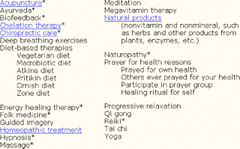This is the first installment of a two-part series on the role of complementary and alternative medicine (CAM) in health-benefits plans. This article covers what’s likely the most extensive CAM program in Corporate America. Part 2 will present viewpoints from others in the corporate, medical, and insurance communities.
October 30,2012
David McCann
| Parker Hannifin (Photo credit: Wikipedia) |
| American Dental Association (Photo credit: Wikipedia) |
As CEO of a Fortune 500 company — this year it’s ranked 216th —Washkewicz could afford to have his old fillings replaced with nonmetallic composite ones and to undergo chelation. That was a good thing, because neither procedure was covered under Parker Hannifin’s health plan.
His next move was to check how many of the 35,000 fillings Parker Hannifin had paid for under its benefit plan the previous year were mercury-laden. The answer: 70%.
“I said, this is insane,” says Washkewicz, eight years later. “We’re poisoning our workforce, paying for it up front, then paying again later for the chronic conditions that result from being poisoned.” Parker Hannifin instituted a policy under which it covered less and less of the costs for silver fillings over the next few years. Now it pays nothing for silver, but 100% for composites.

More notably, Washkewicz’s experience was the genesis of a complete review of Parker Hannifin’s health benefits. The result of that has been a steady expansion since 2004 of procedures, treatments, and therapies covered under the plan (see a partial list, left). Many, unlike the CEO’s treatment of an existing condition, are preventive in nature. And most of the list consists of complementary and alternative (CAM) practices that are rarely covered by health plans. ...
A tug of war between conventional medicine and CAM medicine — much of which is aimed at preventing or treating illness and injury without drugs or invasive approaches — has been going on for decades. While CAM continues to grow in popularity among individuals, the corporate mainstream remains committed to covering only what’s been proven by evidence obtained through large, multiple, and rigorous clinical trials.
“Parker Hannifin is a big outlier, and in fact probably unique in its breadth of coverage,” says Ken Pelletier. A cardiologist by trade, he has been running The Corporate Health Improvement Program for 25 years. Now affiliated with the University of Arizona School of Medicine, the program helps large companies (though not Parker Hannifin) design customized health and wellness initiatives, often using a variety of CAM methods. But that doesn’t mean he offers a blanket approval of Parker Hannifin’s health strategy. (His objections, and other views on the subject of CAM versus traditional medicine, will be addressed in Part 2 of this series.)
| 7-4. Complementary & Alternative Medicines (Photo credit: Peter Morville) |
He stresses that he’s not bashing doctors. ... Nor does he mean to imply that every drug is useless: some pain medications, antibiotics, and thyroid drugs do have merit, the CEO thinks....
... “It’s not going to help us sell more of anything,” he says. “I just think this is the solution to our country’s big heath-care problem. If more and more companies were to do this, we’d have a healthier population and be able to spend money elsewhere instead of pouring all of it into health care.”
| English: graph of age-adjusted percent of adults who have used complementary and alternative medicine: United States, 2002 (Photo credit: Wikipedia) |
Even after eight years, Parker Hannifin, which is quite decentralized and gives its divisions and locations a fair amount of operational autonomy, has not yet been able to aggregate cost impacts for the company as a whole. ...
Says Washkewicz, “It’s early days, but we’re going to aggregate this and show the payoff in lower costs. And then we’re going to publicize the hell out of it. I know we’ll never be able to add up every dollar and penny, because how can you quantify the productivity lost from days missed and doctor visits? But we won’t need to account for every penny. There will be tremendous results.” ...
A big challenge for Parker Hannifin has been putting together a network of CAM practitioners accessible to the majority of its 27,000 workers at 350 locations in North America. ... In some of the more off-the-beaten-path places, practitioners of all the covered CAM services are simply not available.
It’s also important to Washkewicz that the program be on at least a “level playing field” with traditional medicine. That is, the company generally pays for 80% of its employees’ health-care costs, whether for conventional or CAM approaches. “It’s about choice,” he says. “If you are comfortable with the drugs your doctor prescribes, you can keep going to him. But if want to go with less invasive, more holistic, less toxic health care without being stuck on drugs the rest of your life, we’re offering a good place to start.”
Parker Hannifin recently hired a doctor specializing in CAM services, Sherri Tenpenny, to provide counsel on optimizing program results and recommend additional services for inclusion. She patiently went over each of the company’s CAM services with a CFO reporter, ... Most of the time, before going on to the next one, she offered the same comment: “Health plans don’t cover that. But they should.”
Tenpenny started out in emergency medicine and was an emergency-department director for 12 years. “As I started becoming aware of all the integrative CAM tools that are nontoxic and noninvasive but can’t be turned into billion-dollar industries, I spent a couple of years being really angry,” she says. ...
'via Blog this'











No comments:
Post a Comment